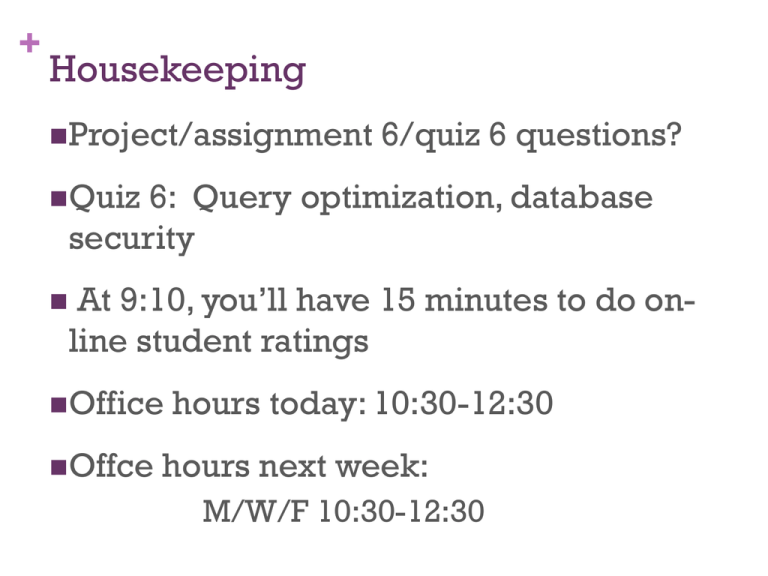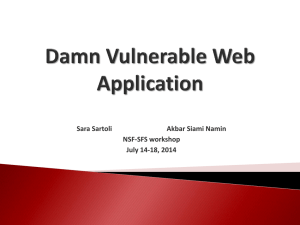SQL Injection Attacks
advertisement

+
Housekeeping
Project/assignment
6/quiz 6 questions?
Quiz
6: Query optimization, database
security
At 9:10, you’ll have 15 minutes to do online student ratings
Office
Offce
hours today: 10:30-12:30
hours next week:
M/W/F 10:30-12:30
+
Security:
Access Control, SQL Injection Attacks
Based upon slides from: classes.soe.ucsc.edu/.../SQL%20Injection%20Attacks.ppt
homes.cs.washington.edu/~suciu/current-trends.ppt
www.cse.iitb.ac.in/dbms/Data/.../DBSecurity-Overview.ppt
+
Data Security
Protection
from malicious attempts to
steal (view) or modify data.
The
science and study of methods of
protecting data (...) from unauthorized
disclosure and modification
Data
Security = Confidentiality +
Integrity
+
4
Traditional Data Security
Security
in statistical databases = Theory
http://en.wikipedia.org/wiki/Statistical_database
In
a statistical database, it is often desired to allow
query access only to aggregate data, not individual
records. Securing such a database is a difficult
problem, since intelligent users can use a
combination of aggregate queries to derive
information about a single individual.
Security
in SQL = Access control + Views
[Griffith&Wade'76, Fagin'78]
+
Access Control in SQL
GRANT privileges ON object TO users
[WITH GRANT OPTIONS]
privileges = SELECT | INSERT | DELETE | . . .
object = table | attribute
REVOKE privileges ON object FROM users
[CASCADE ]
5
+
Access Control in MySQL
http://dev.mysql.com/doc/refman/5.0/en/privilege-system.html
The primary function of the MySQL privilege system is to
authenticate a user who connects from a given host and to associate
that user with privileges on a database such as SELECT, INSERT,
UPDATE, and DELETE
There are some things that you cannot do with the MySQL privilege
system:
You cannot explicitly specify that a given user should be denied access.
That is, you cannot explicitly match a user and then refuse the connection.
You cannot specify that a user has privileges to create or drop tables in a
database but not to create or drop the database itself.
A password applies globally to an account. You cannot associate a
password with a specific object such as a database, table, or routine.
+
7
Views in SQL
A SQL View = (almost) any SQL query
Typically
used as:
CREATE VIEW pmpStudents AS
SELECT * FROM Students WHERE…
GRANT SELECT ON pmpStudents TO DavidRispoli
+
Views in MySQL
http://dev.mysql.com/doc/refman/5.0/en/create-view.html
CREATE [OR REPLACE]
[ALGORITHM = {UNDEFINED | MERGE | TEMPTABLE}]
[DEFINER = { user | CURRENT_USER }]
[SQL SECURITY { DEFINER | INVOKER }]
VIEW view_name [(column_list)]
AS select_statement
[WITH [CASCADED | LOCAL] CHECK OPTION]
The DEFINER and SQL SECURITY clauses determine which
MySQL account to use when checking access privileges for
the view when a statement is executed that references the
view.
+
9
Summary of SQL Security
Limitations:
Often
no row level access control
Note: DB specific – fine-grained access control is
an active area of improvement
Table
creator owns the data (not always fair)
Access control = great success story of the DB
community...
… or
spectacular failure:
Only
~30% assign privileges to users/roles
And then to protect entire tables, not columns
+
MySQL security
http://dev.mysql.com/doc/refman/5.0/en/security.html
Many aspects:
General
factors that affect security. These include
choosing good passwords, not granting unnecessary
privileges to users, ensuring application security by
preventing SQL injections and data corruption, and others.
See Section 6.1, “General Security Issues”.
Security
of the installation itself. The data files, log files,
and the all the application files of your installation should
be protected to ensure that they are not readable or
writable by unauthorized parties. For more information,
see Section 2.18, “Postinstallation Setup and Testing”.
+
MySQL security
Access control and security within the database system itself,
including the users and databases granted with access to the
databases, views and stored programs in use within the database.
For more information, see Section 6.2, “The MySQL Access Privilege
System”, and Section 6.3, “MySQL User Account Management”.
Network security of MySQL and your system. The security is
related to the grants for individual users, but you may also wish to
restrict MySQL so that it is available only locally on the MySQL
server host, or to a limited set of other hosts.
Ensure that you have adequate and appropriate backups of your
database files, configuration and log files. Also be sure that you have
a recovery solution in place and test that you are able to successfully
recover the information from your backups. See Chapter 7, Backup
and Recovery.
+
SQL Injection Attacks
http://www.circleid.com/posts/20130325_sql_injection
_in_the_wild/
+
+
What is a SQL Injection Attack?
Many
web applications take user input from
a form
Often
this user input is used literally in the
construction of a SQL query submitted to a
database. For example:
SELECT
productdata FROM table WHERE
productname = ‘user input product name’;
A
SQL injection attack involves placing SQL
statements in the user input
+
SQL Injection Attacks on the rise
https://www.net-security.org/secworld.php?id=13313
“Many, many sites have lost customer data in this way,” said
Chris Hinkley, Senior Security Engineer at FireHost. “SQL
Injection attacks are often automated and many website
owners may be blissfully unaware that their data could
actively be at risk. These attacks can be detected and
businesses should be taking basic and blanket steps to block
attempted SQL Injection, as well as the other types of attacks
we frequently see.”
+
2012 News of SQL attacks
http://www.mysqlperformanceblog.com/2012/07/18/sql-injectionstill-a-problem/
An SQL injection vulnerability resulted in an urgent June bugfix
release of Ruby on Rails 3.x.
Yahoo! Voices was hacked in July. The attack acquired 453,000 user
email addresses and passwords. The perpetrators claimed to have
used union-based SQL injection to break in.
LinkedIn.com leaked 6.5 million user credentials in June. A class
action lawsuit alleges that the attack was accomplished with SQL
injection.
SQL injection was documented as a security threat in 1998, but new
incidents still occur every month. Making honest mistakes,
developers fail to defend against this means of attack, and the
security of online data is at risk for all of us because of it.
+
Some good sites to learn more
Prevention guide (with sample code in many languages):
http://bobby-tables.com/
Tutorials:
(webinar)
fallacies
http://www.percona.com/webinars/2012-07-25-sql-injection-myths-and-
http://www.netrostar.com/SQL-Injection-Attack
http://www.unixwiz.net/techtips/sql-injection.html
Cool site that let’s you try out attacks on a sample DB and explains
why they work
http://sqlzoo.net/hack/
Research paper on how to retrofit existing websites to combat SQL
injection attacks
http://lersse-dl.ece.ubc.ca/record/205/files/paper.pdf
+
An Example SQL Injection Attack
Product Search:
blah‘ OR ‘x’ = ‘x
This
input is put directly into the SQL statement within the
Web application:
$query = “SELECT prodinfo FROM prodtable WHERE prodname
= ‘” . $_POST[‘prod_search’] . “’”;
Creates
the following SQL:
SELECT prodinfo FROM prodtable WHERE prodname = ‘blah‘ OR
‘x’ = ‘x’
Attacker has now successfully caused the entire database to be
returned.
+
A More Malicious Example
What
if the attacker had instead entered:
blah‘; DROP TABLE prodinfo; --
Results
SELECT prodinfo FROM prodtable WHERE prodname = ‘blah’; DROP TABLE
prodinfo; --’
Note how comment (--) consumes the final quote
Causes
in the following SQL:
the entire database to be deleted
Depends on knowledge of table name
This is sometimes exposed to the user in debug code called during a
database error
Use non-obvious table names, and never expose them to user
Usually data destruction is not your worst fear, as there is low
economic motivation
+
Other injection possibilities
Using
Add
SQL injections, attackers can:
new data to the database
Could be embarrassing to find yourself selling
politically incorrect items on an eCommerce site
Perform an INSERT in the injected SQL
Modify data currently in the database
Could be very costly to have an expensive item
suddenly be deeply ‘discounted’
Perform an UPDATE in the injected SQL
Often can gain access to other user’s system
capabilities by obtaining their password
+
Best defence
If
possible, use bound variables with
prepared statements
Many
libraries allow you to bind inputs to
variables inside a SQL statement
PERL example (from
http://www.unixwiz.net/techtips/sqlinjection.html)
$sth = $dbh->prepare("SELECT email, userid FROM
members WHERE email = ?;");
$sth->execute($email);
See http://bobby-tables.com for example code in many
languages
+
How does this prevent an attack?
The
SQL statement you pass to prepare is parsed and
compiled by the database server.
By specifying parameters (either a ? or a named
parameter like :name) you tell the database engine what
to filter on.
Then
when you call execute the prepared statement is
combined with the parameter values you specify.
It
works because the parameter values are combined with
the compiled statement, not a SQL string.
SQL injection works by tricking the script into including malicious
strings when it creates SQL to send to the database. So by sending
the actual SQL separately from the parameters you limit the risk of
ending up with something you didn't intend.
+
Other Defenses
Use
provided functions for escaping strings
Many
attacks can be thwarted by simply using the SQL
string escaping mechanism
‘ \’ and “ \”
mysql_real_escape_string() is the preferred function for
this
Will
not guard against all attacks
Consider:
SELECT
fields FROM table WHERE id = 23 OR 1=1
No quotes here!
+
More Defenses
Check
syntax of input for validity
Many
classes of input have fixed languages
Email addresses, dates, part numbers, etc.
Verify that the input is a valid string in the language
Some languages allow problematic characters (e.g.,
‘*’ in email); may decide to not allow these
Exclude quotes and semicolons
Not always possible: consider the name Bill O’Reilly
Want to allow the use of single quotes in names
Have
length limits on input
Many
SQL injection attacks depend on entering long
strings
+
Even More Defenses
Scan
query string for undesirable word
combinations that indicate SQL statements
INSERT, DROP, etc.
If
you see these, can check against SQL syntax to see if
they represent a statement or valid user input
Limit
If
database permissions and segregate users
you’re only reading the database, connect to database
as a user that only has read permissions
Never connect as a database administrator in your web
application
+
And Yet More Defenses
Configure
database error reporting
Default error reporting often gives away information
that is valuable for attackers (table name, field name,
etc.)
Configure so that this information is never exposed to
a user





